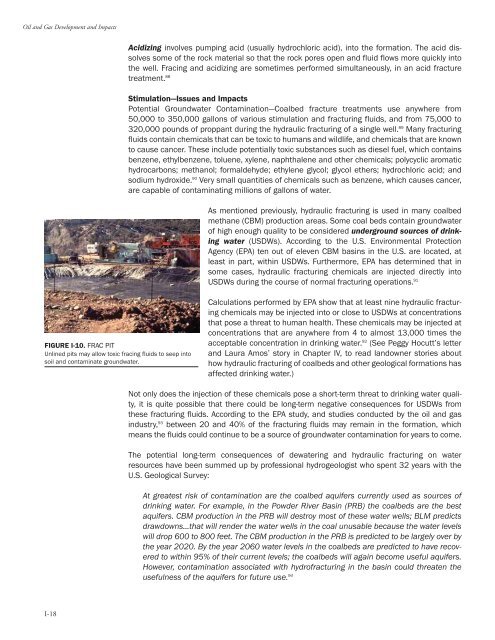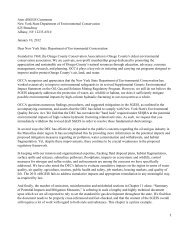Oil and Gas at Your Door? (2005 Edition) - Earthworks
Oil and Gas at Your Door? (2005 Edition) - Earthworks
Oil and Gas at Your Door? (2005 Edition) - Earthworks
Create successful ePaper yourself
Turn your PDF publications into a flip-book with our unique Google optimized e-Paper software.
<strong>Oil</strong> <strong>and</strong> <strong>Gas</strong> Development <strong>and</strong> Impacts<br />
Acidizing involves pumping acid (usually hydrochloric acid), into the form<strong>at</strong>ion. The acid dissolves<br />
some of the rock m<strong>at</strong>erial so th<strong>at</strong> the rock pores open <strong>and</strong> fluid flows more quickly into<br />
the well. Fracing <strong>and</strong> acidizing are sometimes performed simultaneously, in an acid fracture<br />
tre<strong>at</strong>ment. 88<br />
Stimul<strong>at</strong>ion—Issues <strong>and</strong> Impacts<br />
Potential Groundw<strong>at</strong>er Contamin<strong>at</strong>ion—Coalbed fracture tre<strong>at</strong>ments use anywhere from<br />
50,000 to 350,000 gallons of various stimul<strong>at</strong>ion <strong>and</strong> fracturing fluids, <strong>and</strong> from 75,000 to<br />
320,000 pounds of proppant during the hydraulic fracturing of a single well. 89 Many fracturing<br />
fluids contain chemicals th<strong>at</strong> can be toxic to humans <strong>and</strong> wildlife, <strong>and</strong> chemicals th<strong>at</strong> are known<br />
to cause cancer. These include potentially toxic substances such as diesel fuel, which contains<br />
benzene, ethylbenzene, toluene, xylene, naphthalene <strong>and</strong> other chemicals; polycyclic arom<strong>at</strong>ic<br />
hydrocarbons; methanol; formaldehyde; ethylene glycol; glycol ethers; hydrochloric acid; <strong>and</strong><br />
sodium hydroxide. 90 Very small quantities of chemicals such as benzene, which causes cancer,<br />
are capable of contamin<strong>at</strong>ing millions of gallons of w<strong>at</strong>er.<br />
As mentioned previously, hydraulic fracturing is used in many coalbed<br />
methane (CBM) production areas. Some coal beds contain groundw<strong>at</strong>er<br />
of high enough quality to be considered underground sources of drinking<br />
w<strong>at</strong>er (USDWs). According to the U.S. Environmental Protection<br />
Agency (EPA) ten out of eleven CBM basins in the U.S. are loc<strong>at</strong>ed, <strong>at</strong><br />
least in part, within USDWs. Furthermore, EPA has determined th<strong>at</strong> in<br />
some cases, hydraulic fracturing chemicals are injected directly into<br />
USDWs during the course of normal fracturing oper<strong>at</strong>ions. 91<br />
FIGURE I-10. FRAC PIT<br />
Unlined pits may allow toxic fracing fluids to seep into<br />
soil <strong>and</strong> contamin<strong>at</strong>e groundw<strong>at</strong>er.<br />
Calcul<strong>at</strong>ions performed by EPA show th<strong>at</strong> <strong>at</strong> least nine hydraulic fracturing<br />
chemicals may be injected into or close to USDWs <strong>at</strong> concentr<strong>at</strong>ions<br />
th<strong>at</strong> pose a thre<strong>at</strong> to human health. These chemicals may be injected <strong>at</strong><br />
concentr<strong>at</strong>ions th<strong>at</strong> are anywhere from 4 to almost 13,000 times the<br />
acceptable concentr<strong>at</strong>ion in drinking w<strong>at</strong>er. 92 (See Peggy Hocutt’s letter<br />
<strong>and</strong> Laura Amos’ story in Chapter IV, to read l<strong>and</strong>owner stories about<br />
how hydraulic fracturing of coalbeds <strong>and</strong> other geological form<strong>at</strong>ions has<br />
affected drinking w<strong>at</strong>er.)<br />
Not only does the injection of these chemicals pose a short-term thre<strong>at</strong> to drinking w<strong>at</strong>er quality,<br />
it is quite possible th<strong>at</strong> there could be long-term neg<strong>at</strong>ive consequences for USDWs from<br />
these fracturing fluids. According to the EPA study, <strong>and</strong> studies conducted by the oil <strong>and</strong> gas<br />
industry, 93 between 20 <strong>and</strong> 40% of the fracturing fluids may remain in the form<strong>at</strong>ion, which<br />
means the fluids could continue to be a source of groundw<strong>at</strong>er contamin<strong>at</strong>ion for years to come.<br />
The potential long-term consequences of dew<strong>at</strong>ering <strong>and</strong> hydraulic fracturing on w<strong>at</strong>er<br />
resources have been summed up by professional hydrogeologist who spent 32 years with the<br />
U.S. Geological Survey:<br />
At gre<strong>at</strong>est risk of contamin<strong>at</strong>ion are the coalbed aquifers currently used as sources of<br />
drinking w<strong>at</strong>er. For example, in the Powder River Basin (PRB) the coalbeds are the best<br />
aquifers. CBM production in the PRB will destroy most of these w<strong>at</strong>er wells; BLM predicts<br />
drawdowns...th<strong>at</strong> will render the w<strong>at</strong>er wells in the coal unusable because the w<strong>at</strong>er levels<br />
will drop 600 to 800 feet. The CBM production in the PRB is predicted to be largely over by<br />
the year 2020. By the year 2060 w<strong>at</strong>er levels in the coalbeds are predicted to have recovered<br />
to within 95% of their current levels; the coalbeds will again become useful aquifers.<br />
However, contamin<strong>at</strong>ion associ<strong>at</strong>ed with hydrofracturing in the basin could thre<strong>at</strong>en the<br />
usefulness of the aquifers for future use. 94<br />
I-18




